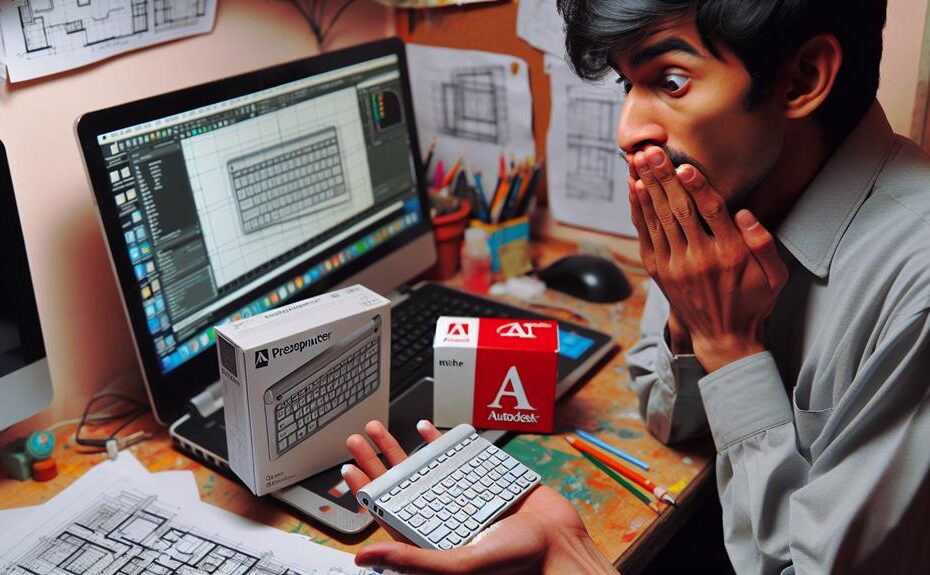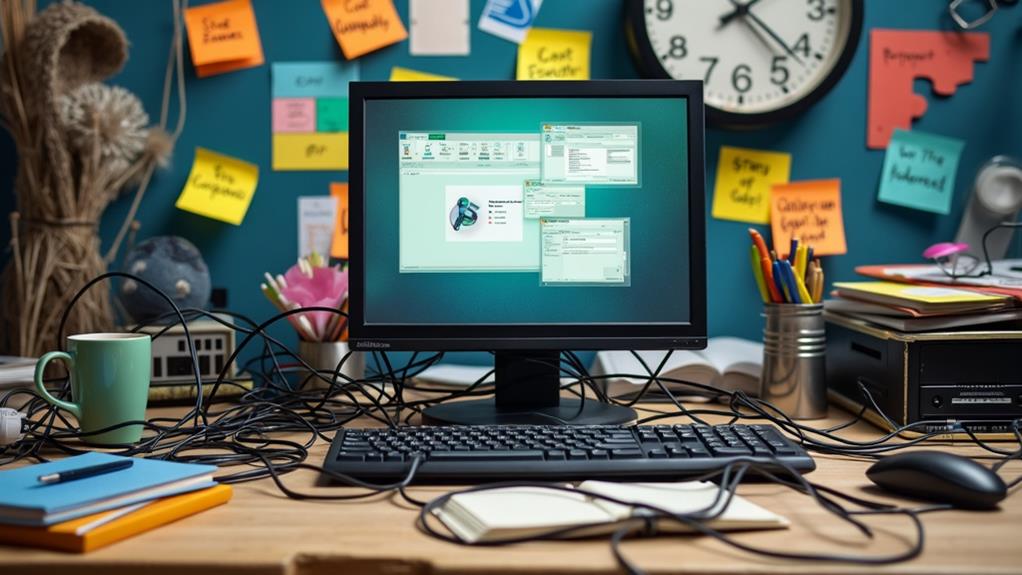



As Hercules once shouldered Atlas' burden, a mini PC bears the weight of running professional software like AutoCAD or Adobe Creative Suite. Surprisingly, these compact computers can handle these demanding applications, though their performance might be tempered by several factors. While they offer space-saving convenience and energy efficiency, it is critical to select the right hardware components and upgrades to guarantee falter-free functionality. Will your mini PC be mighty enough to support the most resource-hungry software?
Key Takeaways
- Mini PCs' processor, memory, and graphics capabilities significantly impact workflow efficiency.
- High-end Intel Core i7/i9 or AMD Ryzen 7/9 CPUs are better suited for professional software like AutoCAD or Adobe Creative Suite.
- Upgrading the processor or graphics card in a mini PC can be challenging or impracticable.
- Thermal management is critical due to the compact design of mini PCs, affecting sustained performance.
- Compatibility issues can arise due to hardware limitations in mini PCs and driver optimizations.
Understanding Mini PC Capabilities
When choosing a mini PC for professional software, you need to contemplate the specific components such as the processor, memory, and graphics capabilities that will impact your workflow efficiency. Both integrated and discrete graphics make a significant difference in performance, especially for tasks like video editing. Since mini PCs are designed to be compact and energy efficient, their cooling systems may not be as robust as those in traditional desktops, which can affect sustained performance under heavy loads. This should lead you to reflect on if the mini PC can support multiple high-resolution monitors, a necessary feature for many professional applications. Upgradeability options also play a pivotal role in determining how well a mini PC can manage demanding tasks over time.
To better evaluate a mini PC's capabilities, you should examine the balance of processing power, RAM, and storage in the configuration you are considering. The sector's developments provide samples that handle professional-grade software, such as the GeForce RTX 3060 Ti and the Ryzen 9 5900H, which offer powerful dedicated graphics and processing capabilities within compact designs. To guarantee that a mini PC can serve your workflow effectively, it is essential to thoroughly assess the hardware specifications and flexibility to handle more demanding applications.
Choosing Between Mini and Desktop
gist of deciding between mini PCs and traditional desktops revolves around fairly balancing compactness and processing power within your workspace. For those who value decluttered space, mini PCs provide a convenient solution, often packed with integrated Intel processors, ample RAM, and various storage options. These compact computers are designed for low energy consumption and suitability for small spaces. However, if you require robust processing power for demanding software applications, a traditional desktop might be the better choice, as it offers greater upgradeability, larger storage capacity, and improved thermal control.
Your work needs directly influence the suitability of each. Classic desktops excel in professional uses such as gaming, content creation, and data-intensive tasks, while mini PCs excel in home entertainment and basic office activities. Weigh your specific needs and preferences to determine which type of computer aligns with your technical requirements.
Processor Considerations
As you contemplate mini PCs for your professional computing needs, it is vital to assess the processor capabilities carefully. When it comes to running resource-intensive software like AutoCAD, processors in mini PCs might not provide the high clock speeds or multi-core architecture necessary for optimal performance. For instance, Intel Core i5 or AMD Ryzen 5 CPUs, commonly found in many mini PCs, can struggle to handle complex 3D modeling, detailed rendering, and real-time visualizations.
These limitations can lead to CPU bottlenecks and significant performance constraints, ultimately affecting your productivity. Furthermore, upgrading the processor in a mini PC can be challenging if not impossible, limiting your ability to future-proof your system for evolving software demands.
This is especially important to ponder when using software tailored for more powerful desktop workstations, such as those with high-end Intel Core i7/i9 or AMD Ryzen 7/9 CPUs.
- 3D modeling and rendering slow down due to insufficient processing power.
- Real-time visualizations become choppy and inaccurate.
- Software crashes occur frequently due to CPU overload.
- Multitasking with multiple applications becomes restricted.
- Upgrading the processor becomes difficult or impossible in mini PCs.
To guarantee seamless performance in demanding professional applications, it is essential to weigh the processing capabilities of mini PCs against your software requirements.
Memory Capacity and Performance
The adequacy of a mini PC's memory capacity is imperative in supporting professional software, as inadequate RAM can considerably hinder performance. For many tasks in AutoCAD and Adobe Creative Suite, 8GB to 16GB of RAM typical in mini PCs can be sufficient. However, more complex, large-scale projects may require additional memory. It is essential to contemplate the specific software and project demands to guarantee seamless operations and prevent memory bottlenecks. As you consider using a mini PC for professional software, remember that integrated graphics may struggle with intensive tasks. Consequently, having a dedicated graphics card can enhance performance immensely. The storage options available in mini PCs, such as solid-state drives (SSDs), can also greatly benefit software load times and system responsiveness. Keep in mind that thermals and cooling are critical due to the compact design of mini PCs. Look to the community experience and follow the terms of use, privacy policy, and cookie policy to ensure the best setup for your needs and professional software demands.
Graphics Card Requirements
With professional software often demanding high-performance graphics capabilities, understanding the specific graphics card requirements for your mini PC is essential. For software like AutoCAD and Adobe Creative Suite, the right graphics card makes a world of difference in the context of performance and overall user experience.
A dedicated graphics card with at least 4GB of VRAM is recommended for professional 3D CAD and rendering applications.
Adobe Creative Cloud applications benefit from a discrete GPU with CUDA or OpenCL acceleration, such as an NVIDIA GTX or RTX series card.
Mini PCs with integrated graphics may struggle with complex 3D models, high-resolution textures, and real-time rendering tasks.
Upgrading the graphics card in a mini PC can dramatically improve performance, but the compact design may limit options.
Workstation-class GPUs like NVIDIA Quadro or AMD Radeon Pro series are optimized for CAD and creative applications, but may not fit in a mini PC.
Storage Options for Resource-Intensive Apps
When you need a mini PC to run demanding software like AutoCAD or Adobe Creative Suite, the storage limitations can be formidable, especially when working with large project files and extensive asset libraries. Mini PCs' internal storage often falls short, but there are several routes you can take to address these needs. First, consider upscaling your mini PC's internal storage by adding high-capacity solid-state drives (SSDs) or combining SSDs with traditional hard disk drives (HDDs). This approach can drastically enhance your storage capacity for large files and asset libraries.
Another viable option is to employ external storage solutions like high-capacity USB drives or network-attached storage (NAS) devices. These can provide additional storage to compensate for the internal limitations of your mini PC. Cloud storage services like Dropbox, Google Drive, or Microsoft OneDrive can also serve as a valuable storage alternative, allowing you to access project files remotely and reduce your local storage requirements.
When choosing a storage configuration for your mini PC, consider factors such as file sizes, project demands, backup needs, and your overall budget. By weighing these considerations, you can optimize your storage setup to guarantee seamless performance while running professional software.
Compatibility and Integration Issues
To guarantee successfully integrating professional software on your mini PC, you must account for potential compatibility issues, which often stem from the device's compact design and limited hardware capabilities.
These challenges can manifest in various ways:
- Limited Hardware: Mini PCs might struggle to run resource-intensive applications like AutoCAD or Adobe Creative Suite due to lower-powered CPUs and lack of dedicated GPUs.
- Upgrade Limitations: Future-proofing your mini PC for evolving software requirements can be difficult due to restricted upgrade options.
- Specialized Peripherals: Integrating required peripherals and add-ons can be problematic on mini PC platforms.
- Graphics Performance: The absence of dedicated GPUs in many mini PCs can hinder the performance of graphics-intensive tasks.
- Software Compatibility: Some professional software may not be optimized for mini PCs, leading to compatibility issues.
Understanding these compatibility and integration challenges is essential to guarantee a smooth and seamless experience with professional software on your mini PC.
Multi-Tasking and Concurrent Usage
Mini PCs exhibit impressive capabilities for multitasking, provided you select hardware that aligns with the demands of your professional software. This aligns with your preferences for utilizing the latest features like multi-monitor support and advanced cooling solutions. For instance, if you need to concurrently run resource-intensive applications like AutoCAD and Adobe Creative Suite, a powerful CPU, dedicated GPU, and sufficient memory are indispensable.
While mini PCs can handle light to medium-duty multitasking, they may struggle with concurrently running highly resource-intensive applications. It is necessary to prioritize component choices when building or purchasing a mini PC for professional usage. Upgradeability and the ability to expand key components like storage, memory, and graphics cards considerably improve the mini PC's suitability for demanding software over time.
Keep in mind that thermal management and cooling solutions play a vital role in sustaining the mini PC's performance during prolonged usage. Indeed, by carefully choosing the right hardware and considering thermal management, you can effectively harness the multitasking potential of mini PCs for professional software applications.
Power Efficiency and Thermal Management
Guarantee your mini PC is configured with strategically selected components and efficient cooling systems to maintain ideal performance during prolonged professional software usage without power-hungry thermal throttling. Effective thermal management is vital for ensuring stable and consistent performance in professional software applications on mini PCs.
- Proper airflow and heat dissipation design: Safeguard proper ventilation to keep components cool and prevent performance degradation.
- Higher-end CPU with better cooling capabilities: Choose CPUs with more cores to handle thermal constraints.
- Component selection and configuration: Balance power efficiency, cooling, and overall system performance for professional use cases.
- Active cooling solutions: Implement fans or liquid cooling systems to maintain maximum temperatures.
- Thermal monitoring and management: Utilize software tools to monitor and control temperatures for ideal performance.
Frequently Asked Questions
Do You Need a Powerful PC for Autocad?
"Autocad's hardware requirements are moderate, so a modern quad-core CPU, 8GB RAM, and a dedicated graphics card can provide suitable performance. But for advanced 3D modeling or rendering, you may need more powerful hardware."
Is a Mini-Pc Good for Photoshop?
'Like a surgeon with a scalpel, you must carefully select a mini PC to optimize its performance limits for Photoshop. Guarantee it has a powerful CPU, ample RAM, and a dedicated graphics card for seamless image editing.'
What Computer Do I Need to Run CAD Software?
To efficiently run CAD software, guarantee your workstation configuration includes a high-performance CPU (e.g., Intel Core i7 or i9), at least 16GB of RAM, a dedicated graphics card, and an SSD for rapid file access.
Which Desktop Is Best for Autocad?
For ideal performance, you should compare workstation requirements such as Intel Core i7 or Ryzen 7 CPUs, NVIDIA GeForce or AMD Radeon GPUs, and 16-32 GB RAM when choosing the best desktop for AutoCAD.
Conclusion
While mini PCs offer a compact alternative for running professional software like AutoCAD or Adobe Creative Suite, their performance is largely limited by their processing power, memory capacity, graphics capabilities, and cooling systems. As a result, they often struggle with complex tasks like 3D modeling, rendering, and video editing. Nevertheless, one intriguing statistic is that some mini PCs can support up to 64GB of RAM, ensuring sufficient memory for basic to moderate usage.
Disclosure: As an Amazon Associate, I earn from qualifying purchases.







